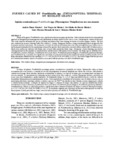Por favor, use este identificador para citar o enlazar este ítem:
http://www.alice.cnptia.embrapa.br/alice/handle/doc/1000333Registro completo de metadatos
| Campo DC | Valor | Lengua/Idioma |
|---|---|---|
| dc.contributor.author | MOREIRA, A. N. | pt_BR |
| dc.contributor.author | OLIVEIRA, J. V. de | pt_BR |
| dc.contributor.author | OLIVEIRA, J. E. de M. | pt_BR |
| dc.contributor.author | SOUZA, G. M. M. de | pt_BR |
| dc.contributor.author | BREDA, M. O. | pt_BR |
| dc.date.accessioned | 2014-11-17T11:11:11Z | pt_BR |
| dc.date.available | 2014-11-17T11:11:11Z | pt_BR |
| dc.date.created | 2014-11-17 | pt_BR |
| dc.date.issued | 2014 | pt_BR |
| dc.identifier.citation | Ciência e Agrotecnologia, v. 38, n. 4, p. 328-334, jul./ago. 2014. | pt_BR |
| dc.identifier.uri | http://www.alice.cnptia.embrapa.br/alice/handle/doc/1000333 | pt_BR |
| dc.description | Thrips of the genus Frankliniella cause significant reduction on grape production. Little is known about its decision making approach in integrated pest management and information on thrips injuries to the vine is scarce, hindering the control of this pest. This study aimed to determine the species of thrips and injuries that cause damage to berries in seedless grapes clusters. The trial was conducted in an area cultivated with Vitis vinifera L., variety Thompson Seedless, using a randomized block design with five treatments and four replications. The treatments consisted of artificial infestation (zero, two, four and eight thrips per inflorescence), and treatment determined by the monitoring system of the grower. Each replication consisted of three plants with 10 inflorescences, which were artificially infested with thrips and covered with nonwoven fabric bags. During the cluster thinning, pre-harvest cleaning and harvest, the numbers of injuried berries and the berries with injuries were evaluated. The thrips species identified were: Frankliniella schultzei (Trybom), Frankliniella brevicaulis Hood, Frankliniella gemina Bagnall, Frankliniella gardeniae Moulton, and Frankliniella sp. A positive and significant correlation was observed between the number of injuries per fruit and the level of thrips infestation, obtained by the equation y = 2.55 + 48.54x (F= 59.98; P= 0.0001; r2= 0.51). The results suggest that the presence of a whitish halo around a small scar on fruit is associated with the presence of adult Frankliniella spp. | pt_BR |
| dc.language.iso | eng | eng |
| dc.rights | openAccess | eng |
| dc.subject | Manejo integrado | pt_BR |
| dc.subject | Nível de infestação | pt_BR |
| dc.subject | Uva sem semente | pt_BR |
| dc.subject | Seedless | pt_BR |
| dc.subject | Danos à planta | eng |
| dc.title | Injuries caused by Frankliniella spp. (Thysanoptera: Thripidae) on seedless grapes. | pt_BR |
| dc.type | Artigo de periódico | pt_BR |
| dc.date.updated | 2014-11-17T11:11:11Z | pt_BR |
| dc.subject.thesagro | Uva | pt_BR |
| dc.subject.thesagro | Doença | pt_BR |
| dc.subject.thesagro | Praga | pt_BR |
| dc.subject.thesagro | Tripes | pt_BR |
| dc.subject.thesagro | Vitis Vinifera | pt_BR |
| dc.subject.nalthesaurus | Grapes | pt_BR |
| dc.subject.nalthesaurus | Frankliniella | pt_BR |
| riaa.ainfo.id | 1000333 | pt_BR |
| riaa.ainfo.lastupdate | 2014-11-17 | pt_BR |
| dc.contributor.institution | ANDRÉA NUNES MOREIRA, INSTITUTO FEDERAL DO SERTÃO PERNAMBUCANO | pt_BR |
| dc.contributor.institution | JOSÉ VARGAS DE OLIVEIRA, UNIVERSIDADE FEDERAL RURAL DE PERNAMBUCO | eng |
| dc.contributor.institution | JOSE EUDES DE MORAIS OLIVEIRA, CPATSA | eng |
| dc.contributor.institution | GEISA MAYANA MIRANDA DE SOUZA, UNIVERSIDADE FEDERAL DA PARAÍBA | eng |
| dc.contributor.institution | MARIANA OLIVEIRA BREDA, UNIVERSIDADE FEDERAL RURAL DE PERNAMBUCO. | eng |
| Aparece en las colecciones: | Artigo em periódico indexado (CPATSA)  | |
Ficheros en este ítem:
| Fichero | Descripción | Tamaño | Formato | |
|---|---|---|---|---|
| Eudes1.2014.pdf | 883,22 kB | Adobe PDF |  Visualizar/Abrir |









